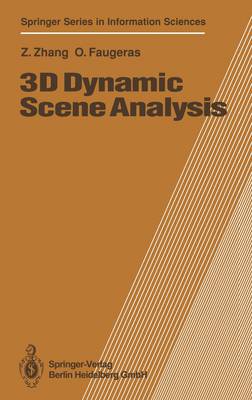
- Retrait en 2 heures
- Assortiment impressionnant
- Paiement sécurisé
- Toujours un magasin près de chez vous
- Retrait gratuit dans votre magasin Club
- 7.000.0000 titres dans notre catalogue
- Payer en toute sécurité
- Toujours un magasin près de chez vous
183,45 €
+ 366 points
Format
Description
1. Introduction.- 1.1 Brief Overview of Motion Analysis.- 1.2 Statement of the "Motion from Stereo" Problem.- 1.3 Organization of The Book.- 2. Uncertainty Manipulation and Parameter Estimation.- 2.1 Probability Theory and Geometric Probability.- 2.2 Parameter Estimation.- 2.2.1 Standard Kalman filter.- 2.2.2 Extended Kalman filter.- 2.2.3 Discussion.- 2.2.4 Iterated ExtendKalman Filter.- 2.2.5 Robustness and Confidence Procedure.- 2.3 Summary.- 2.4 Appendix: Least-Squares Techniques.- 3. Reconstruction of 3D Line Segments.- 3.1 Why 3D Line Segments.- 3.2 Stereo Calibration.- 3.2.1 Camera Calibration.- 3.2.2 Epipolar Constraint.- 3.3 Algorithm of the Trinocular Stereovision.- 3.4 Reconstruction of 3D Segments.- 3.5 Summary.- 4. Representations of Geometric Objects.- 4.1 Rigid Motion.- 4.1.1 Definition.- 4.1.2 Representations.- 4.2 3D Line Segments.- 4.2.1 Previous Representations and Deficiencies.- 4.2.2 A New Representation.- 4.3 Summary.- 4.4 Appendix: Visualizing Uncertainty.- 5. A Comparative Study of 3D Motion Estimation.- 5.1 Problem Statement.- 5.1.1 Line Segment Representations.- 5.1.2 3D Line Segment Transformation.- 5.2 Extended Kalman Filter Approaches.- 5.2.1 Linearization of the Equations.- 5.2.2 Derivation of Rotation Matrix.- 5.3 Minimization Techniques.- 5.4 Analytical Solution.- 5.4.1 Determining the Rotation.- 5.4.2 Determining the Translation.- 5.5 Kim and Aggarwal's method.- 5.5.1 Determining the Rotation.- 5.5.2 Determining the Translation.- 5.6 Experimental Results.- 5.6.1 Results with Synthetic Data.- 5.6.2 Results with Real Data.- 5.7 Summary.- 5.8 Appendix: Motion putation Using the New Line Segment Representation.- 6. Matching and Rigidity Constraints.- 6.1 Matching as a Search.- 6.2 Rigidity Constraint.- 6.3 Completeness of the Rigidity Constraints.- 6.4 Error Measurements inn the Constraints.- 6.4.1 Norm Constraint.- 6.4.2 Dot-Product Constraint.- 6.4.3 Triple-Product Constraint.- 6.5 Other Formalisms Rigidity Constraints.- 6.6 Summary.- 7. Hypothesize-and-Verify Method for Two 3D View Motion Analysis.- 7.1 General Presentation.- 7.1.1 Search in the Transformation Space.- 7.1.2 Hypothesize-and-Verify Method.- 7.2 Generating Hypotheses.- 7.2.1 Definition and Primary Algorithm.- 7.2.2 Control Strates in Hypothesis Generation.- 7.2.3 Additional Constraints.- 7.2.4 Algorithm of Hypothesis Generation.- 7.3 Verifying Hypothesis.- 7.3.1 Estimating the Initial Rigid Motion.- 7.3.2 Propagating Hyphoteses.- 7.3.3 Choosing the Best Hypothesis.- 7.3.4 Algorithm of Hypothesis Verification.- 7.4 Matching Noisy Segments.- 7.4.1 Version 1.- 7.4.2 Version 2.- 7.4.3 Version 3.- 7.5 Experimental Results.- 7.5.1 Indoor Scenes with a Large Common Part.- 7.5.2 Indoor Scenes with a Small Common Part.- 7.5.3 Rock Scenes.- 7.6 Summary.- 7.7 Appendix: Transforming a 3D Line Segment.- 8. Further Considerations on Reducing Complexity.- 8.1 Sorting Data Features.- 8.2 "Good-Enough" Method.- 8.3 Speeding Up the Hypothesis Generation Process Through Grouping.- 8.4 Finding Clusters Based on Proximity.- 8.5 Finding Planes.- 8.6 Experimental Results.- 8.6.1 Grouping Results.- 8.6.2 Motion Results.- 8.7 Conclusion.- 9. Multiple Object Motions.- 9.1 Multiple Object Motions.- 9.2 Influence of Egomotion on Observed Object Motion.- 9.3 Experimental Results.- 9.3.1 Real Scene with Synthetic Moving Objects.- 9.3.2 Real Scene with a Real Moving Object.- 9.4 Summary.- 10. Object Recognition and Localization.- 10.1 Model-Based Object Recognition.- 10.2 Adapting the Motion-Determination Algorithm.- 10.3 Experimental Result.- 10.4 Summary.- 11. Calibrating a Mobile Robot and Visual Navigation.- 11.1 The INRIA Mobile Robot.- 11.2 Calibration Problem.- 11.3 Navigation Problem.- 11.4 Experimental Results.- 11.5 Integrating Motion Information from Odometry.- 11.6 Summary.- 12. Fusing Multiple 3D Frames.- 12.1 System Description.- 12.2 Fusing Segments from Multiple Views.- 12.2.1 Fusing General Primitives.- 12.2.2 Fusing Line Segments.- 12.2.3 Ex...
Spécifications
Parties prenantes
- Auteur(s) :
- Editeur:
Contenu
- Nombre de pages :
- 316
- Langue:
- Anglais
- Collection :
- Tome:
- n° 27
Caractéristiques
- EAN:
- 9783540554295
- Date de parution :
- 23-07-92
- Format:
- Livre relié
- Format numérique:
- Genaaid
- Dimensions :
- 156 mm x 234 mm
- Poids :
- 616 g

Seulement chez Librairie Club
+ 366 points sur votre carte client de Librairie Club
Les avis
Nous publions uniquement les avis qui respectent les conditions requises. Consultez nos conditions pour les avis.






